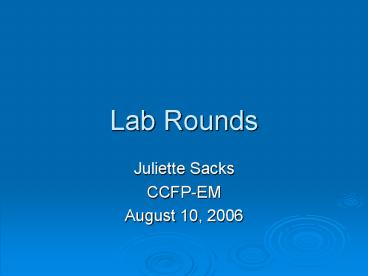Lab Rounds - PowerPoint PPT Presentation
1 / 23
Title:
Lab Rounds
Description:
Lab Rounds Juliette Sacks CCFP-EM August 10, 2006 Case L.W. 49 y.o. Female 3-4 day hx of: disorientation dysarthria progressing ataxia dysphagia no vomiting acute on ... – PowerPoint PPT presentation
Number of Views:68
Avg rating:3.0/5.0
Title: Lab Rounds
1
Lab Rounds
- Juliette Sacks
- CCFP-EM
- August 10, 2006
2
Case
- L.W. 49 y.o. Female
- 3-4 day hx of
- disorientation
- dysarthria
- progressing ataxia
- dysphagia
- no vomiting
- acute on chronic diarrhea
- no hx of trauma, seizures or LOC
- no drug or EtOH abuse
3
Case contd
- FHx adopted
- Collateral Hx from pts daughter who is primary
caregiver - NKDA
- Meds
- Lithium 120mg qhs
- Zyprexa 10mg at noon and 20mg qhs
- Zopiclone 22.5mg qhs
- Propanolol 40mg at noon and 40mg qhs
4
Case contd
- PMHx/Sx
- Bipolar disorder
- Chronic diarrhea
- Multiple laparotomies with ileostomy
- Px
- Tremulous, dysarthric
- 118/56 61 18 36.7C 02 sats 97 on 3L by NP
- Chest clear
- CVS N
- Abdo distended but nontender
- CN intact, clonus, incr. DTRs, generalized muscle
weakness
5
Results
- Na 133, K 3.9
- Troponin, CK, LFTs N, Cr 100
- EtOH, APAP, ASA negative
- Hgb 136, WBC 5.2, Plt 272
- Li 3.96
- EKG Anterior T wave depression
- AXR dilated loops of large bowel with air
fluid levels no free air - CT head N
6
Lithium
- Commonly used to treat depressive and bipolar
affective disorder - Low therapeutic index
- Intoxication seen with acute and chronic use
- Multisystem dysfunction with intoxication
- T1/2 29h
7
Lithium Dosing
- Therapeutic indices
- 0.6 - 1.2 mEq/L (prophylactic control)
- 1.0 - 1.5 mEq/L (acute mania)
- Oral administration only
- Absorbed from GIT 2-4h postingestion
- Minimally protein bound
- Steady state plasma levels achieved in 5d
8
Lithium Excretion
- Excreted through the kidneys therefore dosing is
dependent on renal function, volume status, age - Reabsorbed in the proximal tubule
- 20 is excreted in urine
- Li reabsorption follows Na reabsorption but may
be reabsorped preferentially to counter Na losses
in volume depleted pts
9
More about Li
- Lithium alters the cation transport across cell
membranes in nerve and muscle cells - Influences reuptake of serotonin and epinephrine
- Inhibits second messenger systems involving
phosphatidylinositol cycle - Inhibits postsynaptic D2 receptor sensitivity
10
Factors predisposing to Li Toxicity(courtesy of
Tintinalli)
- Renal failure
- Volume depletion
- Hyperthermia/NMS
- Infection
- CHF
- Diabetes mellitus
- Gastroenteritis
- Surgery
- Cirrhosis
- Decreased Na intake
11
Drug interactions with Li(courtesy of Tintinalli)
- Major Haloperidol
- Moderate
- ACEI - Methyldopa
- Anorexiants - Metronidazole
- Benzodiazepines - NSAIDs
- Caffeine - Phenytoin
- CCB - Tetracyclines
- Carbamazepine - Theophyllines
- Clozapine - Thiazide diuretics
- Fluoxetine - Urea
- Iodide salts - Succinylcholine
- Loop diuretics - Nondepolarizing muscle
paralytics - Phenothiazines - TCAs
- Minor Carbonic anhydrase inhibitors,
sympathomimetics
12
Clinical Manifestations
- GI
- Nausea and vomiting
- Diarrhea
- CNS
- Weakness and fatigue
- Lethargy and confusion
- Tremor (coarse, irregular)
- Ataxia
- Seizures
- Neuromuscular excitability/fascicular twitching
- Stupor
- Coma
13
Clinical Manifestations 2
- Renal
- May cause acute renal failure
- Decreased CrCl
- Nephrogenic diabetes insipidus
- With polyuria and polydipsia
- CV
- Hypotension
- Sinus bradycardia
- Ventricular dysrhythmias (including complete
heart block) - EKG findings in chronic Li use depressed ST
segments and T wave flattening/inversion QTc
prolongation - CV collapse and respiratory failure
14
Clinical Manifestations 3
- Neurological sequelae
- 10 risk of permanent damage
- Truncal and gait ataxia
- Nystagmus
- Short term memory deficits
- Dementia
15
Lithium Toxicity(chronic ingestion)
Level sLi mEq/L Clinical Features Treatment
Grade 1 1.5-2.5 Nausea Vomiting Tremor Hyperreflexia Ataxia Agitation Muscular Weakness Hydration (x 4-6h) Kayexalate
16
Level sLi mEq/L Clinical Manifestations Treatment
Grade 2 2.5-3.5 Stupor Rigidity Hypertonia Hypotension Hydration, Kayexalate, /- dialysis
Grade 3 gt3.5 Coma Seizures Myoclonus Collapse Hemodialysis
17
Treatment
- ABCs
- iv fluids, cardiac monitoring
- EKG
- Identification of agents and amount ingested (get
the pill bottles if possible) - Beware sustained release preparations!
- Rule out co-ingestions
- Serum Li with 2nd sLi 2h later
- Lytes, Cr, BUN, tox screen
- Hx and Px
- /- CT head depending on neurological
presentation
18
Treatment contd
- Restore fluid volume and correct electrolyte
abnormalities - Oral charcoal does not bind Li but may bind other
drugs taken - Whole bowel irrigation may be considered
especially with SR preparations - If given within 1h of ingestion may remove 60 of
drug
19
Hemodialysis
- For severe lithium toxicity
- When?
- sLi gt4.0 mEq/L regardless of clinical status
- sLi gt2.5 mEq/L with symptoms with renal
insufficiency or other factor(s) that limit Li
excretion - sLi 2.5-4.0 mEq/L asymptomatic patient but who
is not expected to have sLi lt1.0mEq/L w/i 36h
20
- Goal decrease sLi levels to lt1 mEq/L within 6-8h
post dialysis - Li clearance of 70-170 ml/min
- Use of continuous venovenous hemofiltration
reduces the post dialysis rebound in sLi level - Addition of bicarbonate to dialysate may improve
Li extraction
21
Adjuncts
- Consult renal service
- Consult psychiatric service
- Consult poison control/toxicology service
22
What about L.W.?
- After 4h of fluid replacement, Li level was 3.53
but she remained symptomatic - Sent for hemodialysis
- No role for gastric lavage, whole bowel
irrigation - Serial Li levels and gt1 course of dialysis
- Persistent neurological deficits despite sLi of
1.0-1.1 mEq/L - Lithium discontinued replaced by olanzepine
23
(No Transcript)































